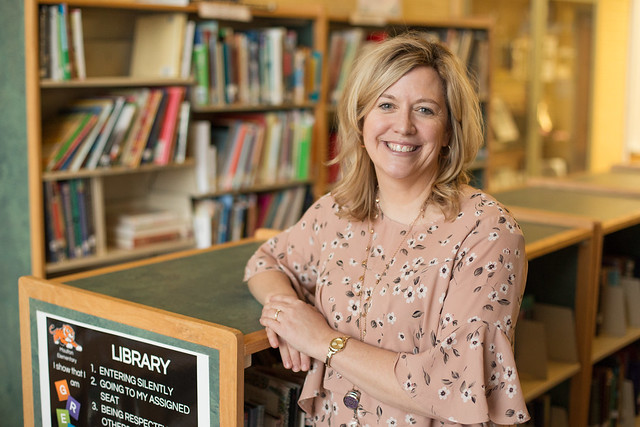Every summer, schools share supply lists of everything students will need to bring with them on the first day. For the 2017-18 school year, recommended kindergarten supplies included crayons, Kleenex, Play-Doh and dry erase markers, to cite just a few items.
In addition to the usual sorts of learning equipment, too many students are also bringing unseen learning impediments with them to school. One in four American kids witness or experience a traumatic event before the age of four. There’s no such thing as a right time for trauma, but it can have especially devastating consequences in the lives of children age five and younger.
That’s where Stephanie McFarland comes in. Since last September, she’s been the DMPS Behavioral Health Services Coordinator, a new position created to combat “The Impact of Childhood Trauma.”
That’s the title of a professional development session McFarland’s delivering around the district over the course of this school year. Wednesday she was at Moulton Elementary School.
“Teachers are key healers,” she told the Moulton staff, and then proceeded to explain.
Trauma isn’t necessarily an isolated event, like the death of a parent. Trauma can be an ambient element in a child’s environment. Poverty can be traumatic if, for instance, it leads to chronic food insecurity. Sometimes kids talk about the “toxic stress” in their lives. Sometimes they don’t. Sometimes their stressors are known. Sometimes they’re not. McFarland reminds teachers that kids communicate with their behavior, and it’s critical to recognize a traumatized child whether you learn the specific causes of their condition or not. Trauma can even be prenatal.
“Children’s brains are 95% developed by age five,” she said. “The framework is essentially complete by then. At that point their learning is like furnishing a newly built house.”
Whereas non-traumatized kids come equipped with a spongy curiosity, traumatized ones are wired for safety and self-defense. They might act out in ways that serve to alert teachers that something is amiss. Or they may internalize their toxic stress at the risk of going dangerously unnoticed.
“Internalized trauma can look like a well-behaved student,” McFarland said. One who is too good for their own good.
The hopeful news is that positive, consistent relationships can ameliorate damage. McFarland’s background as a clinical social worker and therapist in private practice, coupled with her previous DMPS stints in early childhood education, have prepared her to spearhead the district’s aggressive effort to recognize and defuse post-traumatic stress in children. Building on teachers’ foundational desire to be a positive force and influence in their students’ development, she gives them tools that are impactful beyond the academic curriculum.
Using a model designed by the Crisis Prevention Institute, teachers are taught to become the key healers McFarland knows they are uniquely positioned to be by virtue of their daily contact with children. The CPI approach fosters “therapeutic rapport” and effective intervention strategies.
Student supply lists keep getting longer. Teachers, too, need more equipment than ever to get their jobs done. And more teachers of their own.







